Students create temporary exhibits for London’s Virtual Classroom
London Museums: Art, History & Science makes use of the city’s outstanding array of museums and galleries to explore curatorial practice, public outreach, and artistic debates. Students analyse historical and sociological themes from the perspective of both museum visitors and creators. Usually, the course involves weekly site visits to examine the intentional design of ‘blockbuster’ exhibits and other special environments for display and education. In Spring 2020, Professor Sparti and her students made creative use of Virtual London to question physical and digital presentations of art.
In the course’s final assignment, students propose a temporary exhibit with a sample showcase room, analytically arranging objects to teach an external audience about a selected theme. Bobbi Whitney chose to cultivate Room 40 of the V&A, devoted to fashion, with sneakers and labels highlighting the value and meaning of shoes through time.
Culture Measured in Feet
a temporary exhibit proposal for the V&A by Bobbi Whitney
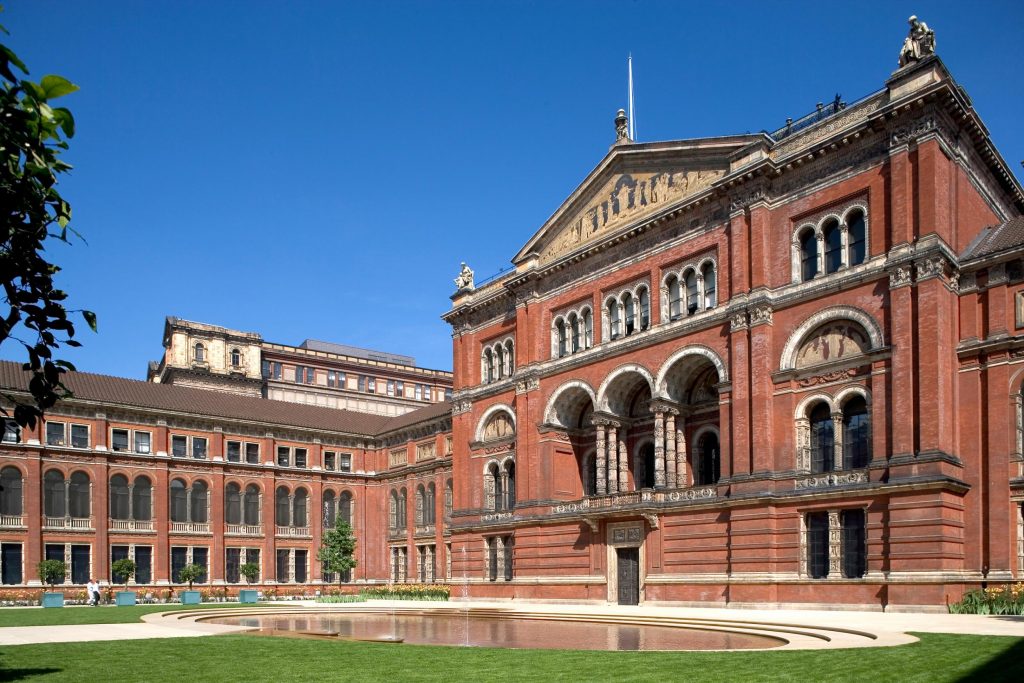 The fashion industry has been turned on its head. Clothing initially was a product of function, but this has changed. Sneakers in particular truly epitomize this transformation. “Footwear is a garment characterized by a long history. In prehistoric times, it was a simple piece of wood or leather and was used to protect the foot. Today shoes are more than functional objects. They convey a wide range of meanings associated with fashion, style, personality, sexuality, gender, and class. (Riello 2006: 1). Sneakers are a status symbol and a piece of high fashion.
The fashion industry has been turned on its head. Clothing initially was a product of function, but this has changed. Sneakers in particular truly epitomize this transformation. “Footwear is a garment characterized by a long history. In prehistoric times, it was a simple piece of wood or leather and was used to protect the foot. Today shoes are more than functional objects. They convey a wide range of meanings associated with fashion, style, personality, sexuality, gender, and class. (Riello 2006: 1). Sneakers are a status symbol and a piece of high fashion.
This led me to create the idea for the temporary exhibit, Culture Measured in Feet. I want this to be a larger shoe exhibit, with one section in particular focusing on sneakers. The goal is to highlight events in the history of sneakers, as well as the way culture shapes the value of items.
This section of the exhibit will have five pairs of sneakers on display. The chosen sneakers are:
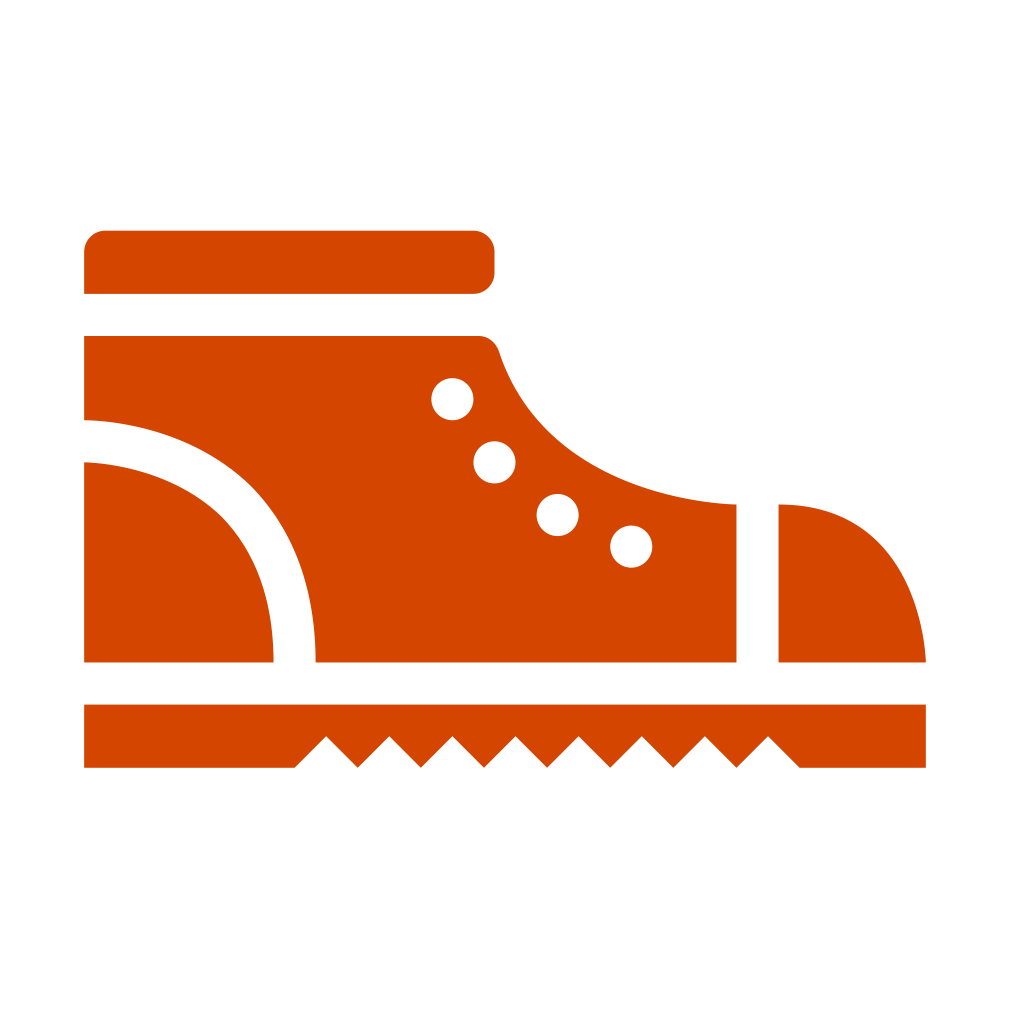 the Jermey Scott x Wings 3.0 Solid Gold by Adidas, on display at the Bata Shoe museum in Toronto;
the Jermey Scott x Wings 3.0 Solid Gold by Adidas, on display at the Bata Shoe museum in Toronto; cleats worn by Olympic Gold Medalist Jesse Owens, owned by the American Federation of Arts;
cleats worn by Olympic Gold Medalist Jesse Owens, owned by the American Federation of Arts; 1970s Nike Cortez sneakers, available for purchase on Ebay;
1970s Nike Cortez sneakers, available for purchase on Ebay; Lebron James equality sneakers, currently on display at the Smithsonian’s National Museum of African American History and Culture;
Lebron James equality sneakers, currently on display at the Smithsonian’s National Museum of African American History and Culture; and red and black Air Jordans, also held by the Smithsonian.
and red and black Air Jordans, also held by the Smithsonian.
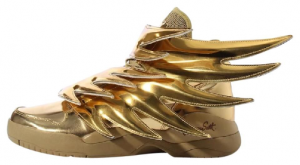
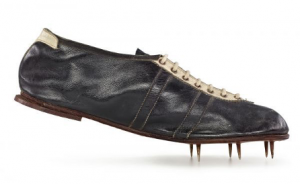
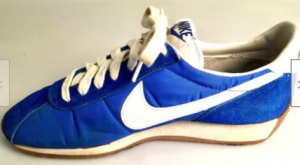
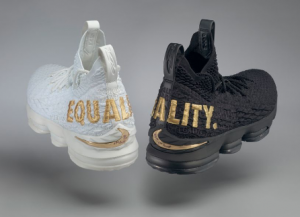
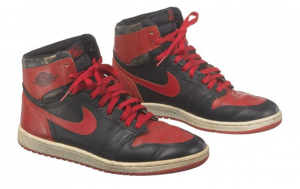
This exhibition will be at the Victoria & Albert Museum in London. This museum draws in a diverse audience, which will be beneficial to the exhibit. The V&A possesses a large shoe collection, which can fill the rest of the exhibition space. Room 40 of the V&A is designated for fashion exhibits, and within this room there is a circular space for temporary exhibits, which will be perfect for Culture Measured in Feet.
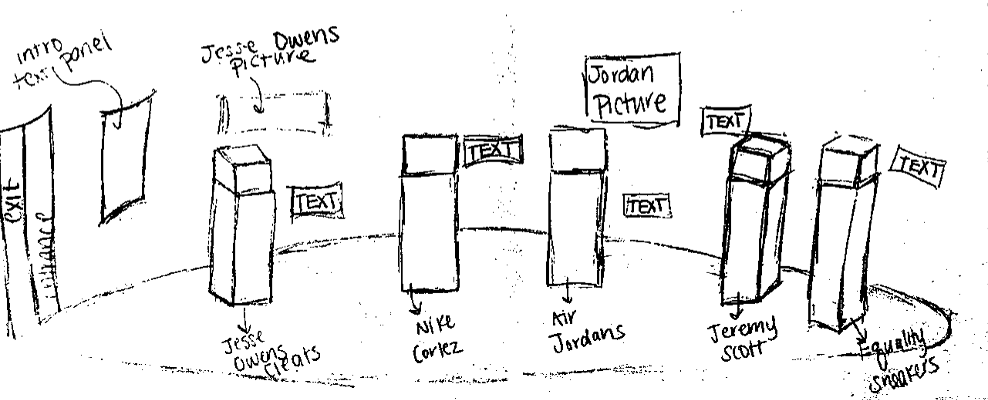
Culture Measured in Feet is intended to attract people of all ages and backgrounds. Museums are spaces for the public, and the most powerful exhibits are those that relate to a wide population. The pieces in this exhibit represent a wide range of time periods, allowing people of different ages to identify with at least one piece. The accompanying labels will give visitors a deeper understanding of each shoe. If their initial appreciation is based on aesthetics, they’ll leave the exhibit feeling more knowledgeable and connected to the pieces.
In order to keep this exhibit as widely accessible as possible, the fee for entrance will be low, thanks to the exhibit’s sponsor, Office. Established in 1981, Office is the “edge fashion footwear specialist” (Office), and has a wide range of shoes for sale. This sponsorship would be beneficial to them because it will further establish Office as an important player in the shoe industry, making consumers who visit the exhibit more likely to shop there in the future.
London Fashion Week (LFW) occurs twice a year, in February and September. Culture Measured in Feet will run throughout the month of February in line with this event. “This event is an important moment within the life of the industry. Widely featured in the press, it is also big business: LFW is a major promotional opportunity for British fashion designers…, LFW mapped out… all the key agents and institutions within the field of fashion.” (Entwistle and Rocamora 736). Fashion weeks are a gathering of important people in fashion, so it is perfect timing to put on an exhibit centered around fashion. Industry professionals will likely be too busy to visit the exhibit during London Fashion Week, so having the exhibit run both before and after will allow people extra time to visit the exhibit if they please. London Fashion Week is a source of inspiration for many. Once becoming inspired by the works they’ve seen in Fashion Week, it can be a beneficial experience to compare current looks to the historical ones displayed in Culture Measured in Feet.
Most pieces included in this portion of the exhibit are currently on or have been on display at various museums. While it may not be possible to also borrow the plinths and glass casings they are currently displayed on, all shoes in Culture Measured in Feet will be displayed on white plinths with glass casings over them. This will allow the public to get a close look at the pieces while still protecting them from theft and damage. The museum space will have a bright, showroom feel and be reminiscent of a high end shoe store. This will be achieved by making the curved walls a stark white, and installing a light hardwood floor. The lighting of the room will be bright, and certain pieces will be back lit in order to create drama. The overall room will be broken up into categories based on type of shoe (i.e., sneakers, heels, etc.), and each portion will be in chronological order based on when they were created or worn.
This exhibit space is circular, and shoes will be kept around the perimeter of the room. The sneaker section of Culture Measured in Feet will make up one portion of the circle. The doorway will be split into two (enter on the left, exit on the right) to control traffic and ensure that people follow the circular direction of the room. “A fashion arises because individuals of low social status copy those of perceived high status. When a trait becomes popular, however, high-status individuals quickly abandon the trait to differentiate themselves from low-status individuals. As a consequence, low-status individuals abandon the traits too, bringing the fashion cycle to an end” (Acerbi, Ghirlanda, and Enquist 1). The circular direction of the exhibit will act as a symbol of fashion as a cyclical system. Upon entering, there will be an intro panel that introduces the sneaker portion of the exhibit. The text of the intro panel will be as follows:
The first sneaker on display will be the Jesse Owens Olympic cleats. There will be a large, black and white image of Jesse Owens on the wall behind the shoe, and the text panel will be on the wall to the right.
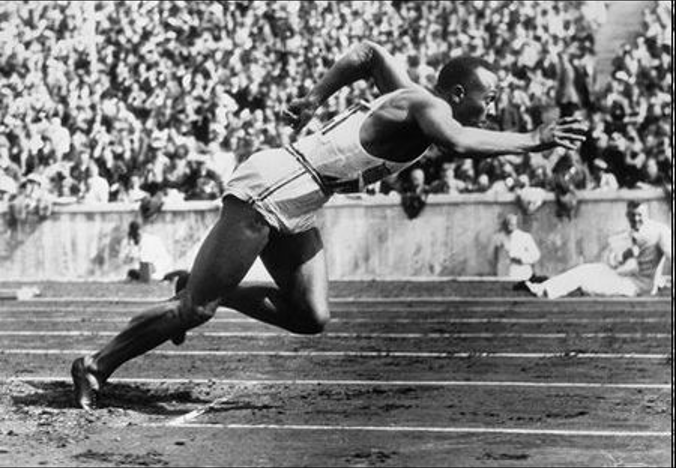
In these shoes, Jesse Owens, a black man, won 4 gold medals, a never-before-seen feat (Laucella 52).
The creator of these shoes, Adolf Dassler, later became the founder of the popular shoe brand, Adidas.
Next to the Jesse Owens cleats will be the Blue 1970s Nike Cortez Sneakers. There will be no accompanying image, but text will be on the wall directly to the right of the shoe that says,
Nike has become the largest and most important athletic shoe company in the world” (Locke Qin and Brause 6), and this shoe, the Nike Cortez, was part of Nike’s very first line. Today, Nike is the epitome of high status in the shoe industry, and creates sneakers for everyone from athletes to red carpet celebrities. They’ve collaborated with many celebrities over the years, and their classic styles such as the Cortez have lasted the test of time and are still a crucial item in the history of the sneaker.
The next sneaker on display will be the black and red Air Jordans. Similar to the Jesse Owens display, there will be an image of Michael Jordan directly behind the shoe and a text panel on the wall to the right.
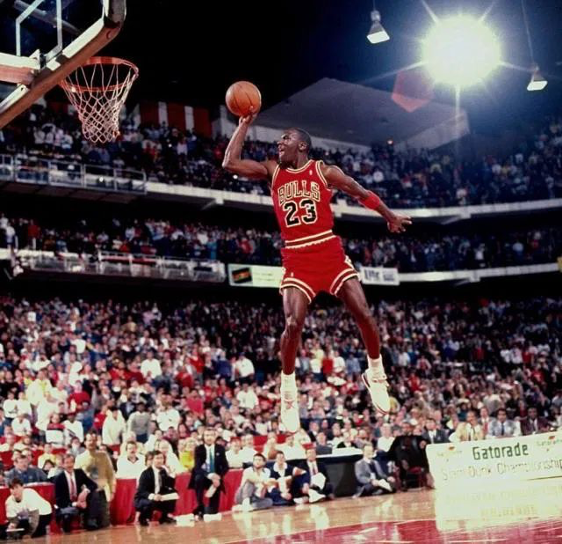
Worn by Michael Jordan himself, a third round draft pick of the Chicago Bulls.
The NBA fined Jordan for wearing the shoes, as they violated uniform guidelines.
Nike paid the $5,000 per-game fine, and Jordan continued to wear the shoes throughout the season, bringing them to the limelight (Footlocker).
Different models of the Air Jordan have since been released, and these shoes are said to have “cemented the (market) power of athletic shoes within mainstream Anglo-American consciousness” (Miner 75).
The final two shoes will be displayed side by side, with less space between them than the previous shoes. The intention here is to have the public view and digest these sneakers simultaneously. While the other sneakers will be displayed around eye level, these sneakers will be a little higher up and will be backlit to add an extra element of drama and importance. All of these choices are an effort to show the visitors the way in which culture has put more value on the sneaker in recent years, and have turned them into something much more than just functional footwear. The Jeremy Scott sneakers will be on the left, with a text panel on the wall to the left, while the Lebron James Equality sneakers will be to the right of the Jeremy Scott shoes, and will have a text panel to the right of them.
In this collaboration with Adidas, Scott shows the fun and fashion elements that can be incorporated into sneakers. These help to establish sneakers as something much larger than function.
When speaking on his own aesthetic he says, “I don’t care if the critics don’t like me. I want to be the people’s designer, like Diana was the people’s princess” (Vogue).
The fashion industry is one that is not often thought of as a serious subject. However, fashion has an immense impact on the lives of everyone. Fashion choices help a person portray themselves to the world, and are a source of joy for many. The fashion industry is made by people, for people, and therefore is a reflection of our values as a society. Culture Measured in Feet has the power to show people the way that beliefs and cultures can impact any object, all the way down to their shoes. Hopefully this exhibit will leave the public entertained, intrigued, and taking a critical look at what they put on their feet everyday.
Bibliography
- Acerbi A., S. Ghirlanda, and M. Enquist M. 2012. “The Logic of Fashion Cycles.” PLoS ONE, 7(3): e32541. doi.org/10.1371/journal.pone.0032541
- Coohill, Joseph. 2016. “Hitler, Jesse Owens, and the 1936 Berlin Olympics.” Professor Buzzkill – History’s Myths Debunked. professorbuzzkill.com/hitler-jesse-owens-1936-berlin-olympics/
- Engvall, Nick. 2019. “Michael Jordan Photos.” Sneaker History. sneakerhistory.com/2018/02/10/53-michael-jordan-photos/
- Entwistle, Joanne and Agnès Rocamora. 2006. “The Field of Fashion Materialized: A Study of London Fashion Week.” Sociology, 40(4): 735–751. doi:10.1177/0038038506065158
- Foot Locker. “History of Air Jordan.” footlocker.com/history-of-air-jordan.html
- Kawamura, Yuniya. 2016. “Introduction: Placing Sneakers within Sociology.” Sneakers: Fashion, Gender, and Subculture. London: Bloomsbury Academic.
- Laucella, Pamela C. 2016. “Jesse Owens, a Black Pearl amidst an Ocean of Fury: A Case Study of Press Coverage of the 1936 Berlin Olympic Games.” In From Jack Johnson to LeBron James: Sports, Media, and the Color Line edited by Chris Lamb, 52-85. University of Nebraska Press.
- Locke, Richard M., Fei Qin and Alberto Brause. 2007. “Does Monitoring Improve Labor Standards? Lessons from Nike.” Industrial and Labor Relations Review, 61(1): 3–31.
- Office. “About Us.” www.office.co.uk/view/content/about-us-page
- Smithsonian. 2018. “‘Equality’ Basketball Shoes Game-Worn by LeBron James.” National Museum of African American History and Culture. nmaahc.si.edu/object/nmaahc_2018.58ab
- Vogue. “Jeremy Scott News, Collections, Fashion Shows, Fashion Week Reviews, and More.” vogue.com/fashion-shows/designer/jeremy-scott